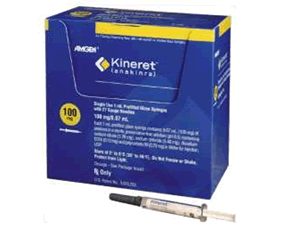Kineret Side Effects
 Severe Side Effects of Kineret
Severe Side Effects of Kineret
- The use of Kineret may result in neutropenia (reduced white blood cell count) and an increased risk of infection (due to the lack of white blood cells).
- Contact your doctor right away if you develop flu-like symptoms or signs of an infection. These may include high fever, chills, persistent sore throat, coughs with mucus, runny nose, nasal congestion, severe headache or bone pain.
Common Side Effects of Kineret
- Redness and irritation at the injection site are common when using Kineret. These conditions may last two to four weeks. If they do not clear up by then, tell your doctor immediately.
- Seek medical attention if your headaches, nausea, diarrhea and sinus irritation worsen or do not go away.
Warnings & Recalls for Kineret
General Warnings About Kineret
- Using Kineret may raise your risk of developing serious infections. Notify your doctor right away if you develop flu-like symptoms or signs of an infection.
- Do not take Kineret if you have marrow or kidney disease, or if you have recently been exposed to diseases like chickenpox, measles or influenza.
- Do not take Kineret if you have a suppressed immune system or have recently had a vaccination of any kind.
- Before starting Kineret, tell your doctor about your medical history, especially if you have had recurring infections, immune system problems, kidney disease or asthma.
- Before starting Kineret, tell your doctor if you are already using Enbrel | etanercept, Remicade | infliximab or Humira | adalimumab.
- Before starting Kineret, females should talk to their doctors if they are pregnant or breastfeeding.
Kineret Treatment and Use
Kineret | Anakinra is an interleukin 1 family receptor antagonist that treats pain and swelling in adult patients with moderate to severe rheumatoid arthritis. It is used when other prescribed drugs have proven to be ineffective. Kineret is manufactured by Amgen and was approved for use in 2001.
How does Kineret work?
Kineret works by impeding the actions of proteins in the human body that cause inflammation.
Dosage
- Kineret is available in either a pre-filled syringe or an injector called the Simpleject. The daily dosage is 100 milligrams.
- Patients usually receive their first dose of Kineret in a doctor’s office. After that, they may use Kineret at home as long as they or friends have been instructed in the proper way of injecting it.
- Store Kineret in your refrigerator until 60 to 90 minutes before you are ready to use it. Do not freeze it. Remove the injector or syringe from its packaging and place it on a flat surface so that it may warm up to room temperature. Do not attempt to warm it in boiling water or in the microwave.
- Before you use Kineret, make sure that the substance in it is not discolored nor contains large particles. If it does, contact your pharmacist and report the problem. Additionally, ask about the best way of discarding used syringes or autoinjectors.
- Clean the injection site with rubbing alcohol and let it dry completely before using Kineret. It may be injected into the outer thighs, upper arms, buttocks or anywhere on the stomach except the navel and the two-inch area around it. Do not inject Kineret into tender, bruised, red, scarred or stretch-marked skin. Be sure to rotate application sites every time. Choose a new spot that is at least one inch away from a previously used spot.
- Notify your doctor if you accidentally miss a dose of Kineret.
- Stop using Kineret and talk to your doctor if your condition worsens or does not improve after four weeks.
- Your doctor may advise you to use Kineret in combination with other drugs. While using Kineret, do not receive any vaccinations without your doctor’s consent.
Other Names for Kineret
Brand Name:
Generic Name:
Lawsuits & Legal Information for Kineret
Author:
HenryL
Posted on Oct 10, 2012
 Severe Side Effects of Kineret
Severe Side Effects of Kineret